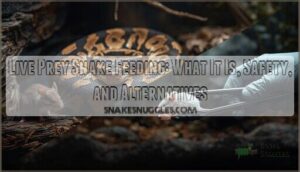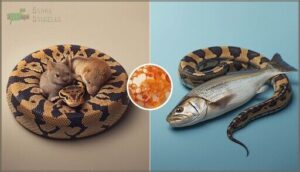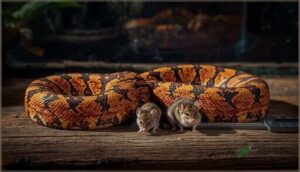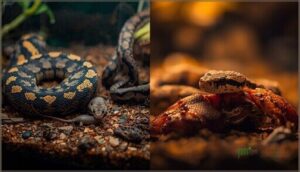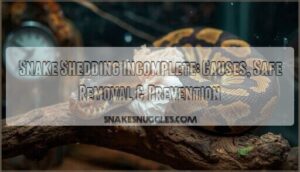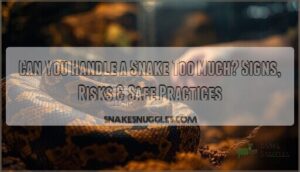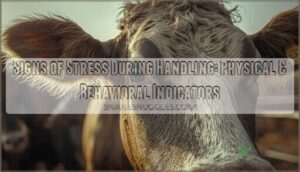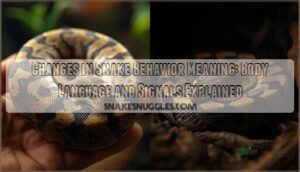This site is supported by our readers. We may earn a commission, at no cost to you, if you purchase through links.
Your ball python hasn’t eaten in weeks, and someone suggests dropping a live mouse into the enclosure. The mouse squeaks, your snake strikes, and suddenly you’re dealing with what looks like a crime scene—except it’s your snake bleeding from a defensive bite to the face.
Live prey snake feeding triggers the hunting instincts snakes evolved over millions of years, but that primal satisfaction comes packaged with risks most keepers don’t anticipate. Surveys show that somewhere between 8 and 12 percent of captive snakes end up with lacerations from prey that fought back, and those wounds often carry infections that complicate everything.
You don’t have to choose between honoring your snake’s natural behavior and keeping it safe—understanding when live feeding makes sense and when safer alternatives work just as well puts you in control of your snake’s health and welfare.
Table Of Contents
- Key Takeaways
- What is Live Prey Snake Feeding?
- Choosing Safe and Suitable Live Prey
- Benefits and Risks of Live Prey Feeding
- Ethical and Welfare Concerns
- Safer Alternatives to Live Prey
- Troubleshooting Feeding Challenges
- Frequently Asked Questions (FAQs)
- How do you feed a snake live prey?
- Do snakes eat live prey?
- Should you feed a snake pre-killed prey?
- How often should you feed a snake?
- What happens if you feed a snake live prey?
- Can you freeze snake food?
- How often should I feed my snake?
- Can snakes recognize their owners during feeding time?
- What temperature should the feeding enclosure be?
- Should I feed my snake in a separate container?
- Conclusion
Key Takeaways
- Live prey feeding triggers natural hunting instincts but carries serious risks including defensive bites that cause injuries in 8–12% of captive snakes, bacterial infections from wounds, and disease transmission from rodent pathogens.
- Frozen-thawed prey delivers identical nutritional value to live prey without safety hazards, making it the recommended feeding method that protects both your snake and the prey animal from unnecessary harm.
- Live feeding should be your last resort reserved only for extreme cases like prolonged anorexia or snakes with genuine movement dependency, after you’ve exhausted safer alternatives like proper thawing, scenting techniques, and environmental adjustments.
- Ethical and legal considerations increasingly restrict live vertebrate feeding in many regions including parts of Australia and the EU, where animal welfare codes now prohibit the practice unless no reasonable alternative exists and your snake’s health depends on it.
What is Live Prey Snake Feeding?
Live prey snake feeding is exactly what it sounds like—offering your snake a living animal to hunt and consume. This practice activates a snake’s natural predatory instincts, but it comes with considerations you need to understand before making the choice.
Let’s break down what live feeding actually involves, which prey types are commonly used, and how this approach compares to other feeding methods.
Definition and Basic Principles
Live prey snake feeding means you’re offering conscious, mobile animals—usually rodents—to your snake, as opposed to pre-killed or frozen options. This practice comes with serious trade-offs:
- Feeding mechanics: Your snake strikes, constricts, and swallows the moving prey, which can take minutes to over an hour depending on species.
- Biological principles: Live prey triggers hunting instincts through heat, scent, and motion—but your snake gets the same nutrition from dead prey.
- Health principles: Veterinary experts warn that rodents can bite back, causing deep wounds or infections that conflict with modern welfare standards. For the snake’s safety, it’s best to avoid feeding live prey.
Professional consensus? Live feeding should be your last resort, not your default.
Commonly Used Live Prey Types
Most captive snakes eat rodents—specifically live mice and rats—though you’ve got other options depending on species. Day-old chicks can be a valuable option, as they offer high energy value for domestic snakes.
Here’s what you’ll encounter:
| Prey Type | Common Examples |
|---|---|
| Rodent Nutrition | Mice, rats, multimammate mice |
| Avian Alternatives | Day-old chicks, small quail |
| Insect Variety | Crickets, roaches, worms |
| Fish Feeders | Minnows, goldfish, amphibians |
That prey diversity matters because your snake’s natural diet determines what it’ll accept. Understanding these live rodents and alternatives gives you control over feeding safely.
How Live Feeding Differs From Alternatives
When you feed live prey, your snake experiences behavioral engagement that frozen-thawed prey can’t match—but that choice carries serious trade-offs. Live vs frozen-thawed prey isn’t just about preference.
Microbiological risks and injury hazards stack up against live feeding, while nutrient retention stays nearly identical across pre-killed prey and frozen options.
The ethical implications matter, too, since frozen-thawed prey eliminates suffering without compromising your snake’s health.
Choosing Safe and Suitable Live Prey
If you’re going to feed live prey, getting the match right between your snake and its meal isn’t just important—it’s essential for both animals’ safety.
You can’t just toss any rodent into the enclosure and hope for the best. Let’s look at what you need to think about when selecting prey that won’t put your snake at risk.
Species-Specific Dietary Needs
Different snake species have evolved to thrive on wildly different menus. Rodent-eating pythons and colubrids need diets with 30–50% protein, while piscivorous snakes like garter snakes require thiamine supplementation when fed fish to prevent vitamin B1 deficiencies.
Prey diversity matters—mono-diets of domestic rodents can trigger obesity risks in low-activity snakes. Understanding your species’ dietary needs prevents nutritional problems down the road.
Selecting Appropriate Prey Size
Getting prey size right isn’t guesswork—it’s precision snake care. Choose live prey with a width matching your snake’s thickest body point, never exceeding 1.5 times that girth. Weight percentage matters too: aim for prey around 10% of your snake’s mass per feeding.
Oversized prey brings injury risks, regurgitation, and stress. Growth stages shift these ratios slightly, but violating size guidelines courts trouble.
Age and Health Considerations for Prey
Beyond size, prey age shapes nutritional differences and pathogen risks in feeder rodents. Younger prey animals like pinkies deliver less fat than adults, while weanlings at three to four weeks offer balanced minerals for peak nutrition.
Best practices demand sourcing from health-monitored suppliers—both live and frozen rodent care matters, since freezing doesn’t eliminate Salmonella. Prioritize disease prevention through proper handling and reputable sources.
Benefits and Risks of Live Prey Feeding
Live prey feeding isn’t a simple yes-or-no decision. It comes with real advantages that appeal to a snake’s natural instincts, but it also carries serious risks you can’t ignore.
Here’s what you need to weigh before making your choice.
Stimulation of Natural Behaviors
When your snake strikes at live prey, you’re watching millions of years of evolution in action. This feeding method triggers the full predatory sequence—orientation, striking, constriction, and ingestion—letting your snake express natural hunting instincts and motor patterns that frozen food can’t replicate.
Research shows enrichment benefits include improved foraging efficiency, faster growth, and sharper problem-solving abilities when snakes engage their innate predatory drive through live feeding behavior.
Nutritional Value and Absorption
Live prey delivers a nutritional punch that’s hard to beat. Whole rodents pack roughly 30–60% protein and 25–60% fat on a dry-matter basis, giving your snake concentrated fuel from every bite.
Digestibility trials across three snake species confirm comparable protein absorption whether you’re feeding mice, chicks, or bats.
- Excellent digestibility: Fat absorption rates hit 97–98% with mice and bats, ensuring maximum nutrient bioavailability
- Mineral balance: Whole prey naturally provides calcium-to-phosphorus ratios near 2:1, supporting bone health without supplements
- Zero nutrient degradation: Freshness means no oxidation or vitamin loss from storage
Risks of Injury, Disease, and Parasites
Prey Bite Wounds pose a real danger—surveys show 8–12% of captive snakes suffer lacerations, with some cases needing surgery after rodent attacks. Bacterial Infections complicate recovery when bites introduce Gram-negative organisms.
Rodent Pathogens like Salmonella contaminate feeder surfaces even when frozen, while Parasite Transmission from infested prey overloads your snake’s system.
These Zoonotic Risks extend to you, making live prey a gamble for both animal welfare and safety concerns.
Ethical and Welfare Concerns
Live prey feeding isn’t just about what works for your snake—it raises serious questions about the animals being fed.
The welfare of prey animals, along with ethical guidelines and legal restrictions, plays a bigger role in this practice than many snake owners realize.
Let’s look at the key concerns you need to understand before deciding how to feed your snake.
Animal Welfare Guidelines
International regulations now shape how you can ethically feed your snake. The European Convention for the Protection of Pet Animals requires that both predators and prey experience minimal suffering.
In Australia and several EU countries, you can only use live vertebrate prey when no reasonable alternative exists and your snake’s health depends on it. The RSPCA goes further, stating there’s no justification for feeding live rodents to companion snakes under normal circumstances.
Stress and Suffering in Prey Animals
What happens to the prey during live feeding? Rodents experience acute fear indicators—freezing, explosive escape attempts, and rapid heart rate spikes—within seconds of encountering your snake. Research shows mice and rats commonly die within one minute after constriction, but that minute involves intense physiological panic.
Chronic stress from repeated predator exposure can cause lasting anxiety-like behavior and suppress immune function. Unlike wild settings, captive enclosures offer no escape, prolonging distress before the strike.
Humane endpoints in laboratory settings recognize when suffering becomes unacceptable, yet live feeding routinely crosses those thresholds. Ethical perspectives increasingly question whether stimulating natural behaviors justifies preventable pain, especially when frozen alternatives meet your snake’s nutritional needs without the welfare costs.
Live feeding crosses ethical lines that lab standards forbid, raising the question: does hunting instinct justify preventable suffering when frozen prey works just as well?
Legal and Regulatory Considerations
Beyond ethics lies the law. You might assume feeding your snake is purely personal, but animal welfare and reptile welfare codes increasingly shape what’s legal. In some regions, live vertebrate prey is flat-out prohibited unless your snake would otherwise starve—enforcement liability is real.
Consider these regulatory realities:
- Animal cruelty laws in all 50 U.S. states criminalize unnecessary suffering, with felony penalties in many jurisdictions
- Australian codes explicitly ban live vertebrate feeding in New South Wales, linking violations to cruelty offences
- International trade rules under CITES require permits for many snake species, complicating legal sourcing
- Research oversight mandates humane protocols and institutional review before any vertebrate feeding study
- Enforcement increasingly targets routine live prey use without documented necessity, especially where suffering is prolonged
Ignorance won’t shield you. Before offering live prey, verify your local laws—what’s standard practice elsewhere might expose you to prosecution where you live.
Safer Alternatives to Live Prey
You don’t have to choose between your snake’s health and your peace of mind. Frozen-thawed and pre-killed prey offer the same nutritional value without the risks that come with live feeding.
Let’s look at your options and how to use them effectively.
Frozen-Thawed and Pre-Killed Prey Options
Frozen-thawed prey offers safety advantages that live feeding can’t match—no bites, scratches, or escape risks. Disease control improves because freezing kills many parasites.
You’ll also enjoy economic benefits through bulk storage and lower costs. Pre-killed prey acts as a middle ground when converting your snake.
Following proper preparation protocols ensures your reptile gets the best nutrition without the dangers of live snake feeding.
Nutritional Comparison to Live Prey
You might worry that switching to frozen-thawed prey compromises reptile nutrition, but the facts tell a different story. Properly stored frozen rodents deliver macronutrient profiles nearly identical to live prey—same protein, fat, and mineral balance your snake needs.
Here’s what freezing preserves:
- Calcium and phosphorus concentrations remain stable
- Protein and fat content stay within natural variation ranges
- Pathogen reduction greatly improves safety
While vitamin stability can decline during extended frozen storage, you can easily address this with supplementation.
The practical equivalence between live prey and frozen-thawed prey means your snake won’t suffer nutritionally. Professional facilities worldwide rely on frozen feeding protocols with excellent results—proof that nutrient density doesn’t depend on whether dinner still moves.
Feeding Techniques and Best Practices
Successful snake feeding starts with proper thawing—refrigerate frozen prey overnight, then warm it to about 43–45°C using warm water to trigger thermal cues. Use feeding tongs to deliver prey and gently simulate movement if needed. Stick to a feeding schedule matched to your snake’s age: juveniles every 5–7 days, adults every 7–14 days. Always provide a quiet environment, avoiding disturbance 24–48 hours before and after meals to prevent regurgitation.
| Feeding Technique | Purpose |
|---|---|
| Warming prey to body temperature | Triggers strike response through thermal cues |
| Using feeding tongs | Prevents hand-food association and bite risk |
| Minimal enclosure disturbance | Reduces stress and improves feeding success |
Troubleshooting Feeding Challenges
Even the healthiest snakes sometimes refuse food, and it can leave you wondering if something’s wrong. Understanding when live prey might actually help—and when it won’t—makes all the difference in resolving feeding problems.
Here’s what to watch for and how to encourage your snake to eat consistently.
When Live Prey May Be Necessary
Most snakes thrive on frozen-thawed prey, but there are exceptions. Some snakes exhibit movement dependency, refusing still prey but striking at live prey immediately. Wild-caught snakes and neonates may initially reject non-live food.
Veterinary exceptions include prolonged anorexia cases where health is at risk. After adjustment failure despite warming, scenting, and presentation adjustments, supervised live feeding can prevent dangerous weight loss.
Encouraging Feeding in Reluctant Snakes
What triggers a stubborn snake to finally strike? Environmental adjustments like proper temperatures and humidity often restore appetite.
Scenting techniques—rubbing prey with chicken or exposing brain tissue—can entice reluctant snakes. Prey presentation matters too: try different rodent colors, sizes, or types.
Behavioral stimulation through tong movement mimics live motion. If these feeding techniques fail, veterinary involvement ensures you’re not missing underlying health issues.
Signs of Feeding Issues and When to Seek Help
When does a missed meal become a medical emergency? Prolonged anorexia beyond a few weeks, especially with weight loss or visible spine ridges, signals trouble. Watch for these urgent signs requiring veterinary assistance:
- Repeated regurgitation over 1–2 months
- Respiratory indicators like wheezing or open-mouth breathing
- Oral lesions or abnormal discharge
- Gastrointestinal symptoms alongside food refusal
- Declining body condition despite troubleshooting feeding challenges
Frequently Asked Questions (FAQs)
How do you feed a snake live prey?
Supervised feeding means you place the prey in your snake’s enclosure, watch closely for 20–30 minutes, and remove any uneaten animal immediately to prevent injury from defensive bites or stress.
Do snakes eat live prey?
Yes, wild snake diets consist almost entirely of live prey.
In captivity, many owners choose live feeding to stimulate hunting instincts, though this practice carries risks of live prey injuries and raises animal welfare concerns.
Should you feed a snake pre-killed prey?
Pre-killed prey eliminates safety risks of live feeding while maintaining nutritional value. It considers ethical concerns and animal welfare standards.
Most snakes adapt readily to prekilled prey, making it the recommended choice for responsible snake feeding.
How often should you feed a snake?
Your snake’s feeding schedule hinges on age and species. Juveniles need meals every 5–7 days, while adults thrive on 1–4 week intervals. Overfeeding risks obesity, and brumation naturally slows appetite.
What happens if you feed a snake live prey?
Feeding live prey can result in snake injuries from defensive bites, disease transmission from pathogens, and prey suffering in confined spaces.
Legal implications vary by region, with frozen comparison showing safer outcomes for animal welfare.
Can you freeze snake food?
Like preserving summer’s harvest for winter, you can freeze snake food—storing rodents at –18°C for months.
Frozen-thawed prey offers nutritional value comparable to fresh while eliminating injury risks and welfare concerns inherent in live feeding.
How often should I feed my snake?
Your snake’s feeding routine depends on age, species differences, and body condition. Hatchlings usually eat every five to seven days, while adults often wait two to six weeks. Activity level and prey size also matter.
Can snakes recognize their owners during feeding time?
Your snake can’t recognize you like a dog does, but it learns your scent through habituation effects.
Learned association links your presence to feeding responses, creating a positive feeding experience that reduces stress over time.
What temperature should the feeding enclosure be?
Your enclosure should stay between 80°F and 85°F, with a basking spot around 90°F to 92°F.
Ideal digestion depends on species variation, proper hydration effects, and prey temperature matching live rodents at approximately 98°F.
Should I feed my snake in a separate container?
You don’t have to. Both methods work. Some keepers prefer separate containers to avoid substrate ingestion and bite risk, while others value enclosure stability.
Individual variation matters more than location—focus on consistent routines and minimal relocation stress.
Conclusion
Like choosing between a wild hunt and a well-stocked pantry, live prey snake feeding demands you weigh instinct against injury. You’ve seen the risks—defensive bites, infections, ethical questions—and you’ve learned the alternatives that keep your snake fed without the blood.
The choice isn’t about right or wrong; it’s about informed control. You know what your snake needs, what the prey endures, and which path benefits both welfare and wisdom best.
- https://rethinkpriorities.org/research-area/rodents-farmed-for-pet-snake-food/
- https://kb.rspca.org.au/knowledge-base/is-it-necessary-to-feed-my-pet-reptile-live-prey/
- https://crittery.co.uk/info/issues-with-live-feeding
- https://www.rodentpro.com/informationcenter/resources/feeding-frozen-vs-live-reptiles
- https://assets.publishing.service.gov.uk/media/5a7a0ccce5274a34770e3e2f/codeofpracticereptiles.pdf

